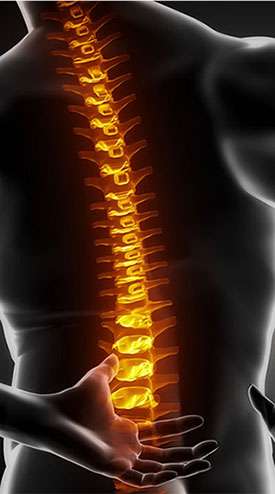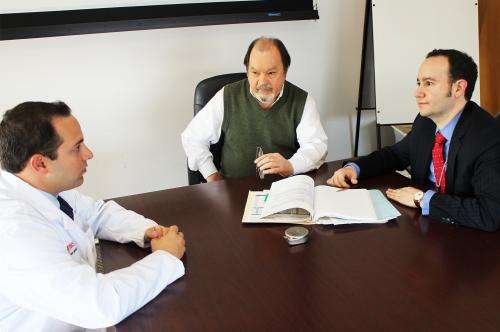New approach to stop chronic pain

The pain in Sequoia Lawson's right arm grew so severe that she could not lift it to shake hands.
Nothing worked to dull the pain from what doctors said was nerve damage – not medication, physical therapy or multiple surgeries. That is, until she took the 3,000-mile trip from her home in Washington State to Rutgers Biomedical and Health Sciences in Newark.
Lawson, 30, had learned of the work of neurosurgeon Antonios Mammis at Rutgers New Jersey Medical School treating pain through spinal cord stimulation. Mammis often consults with colleagues as part of a new interdisciplinary approach to pain management at Rutgers.
"I had suffered with pain for more than a decade and was willing to try anything," she recalled.
Mammis and pain management anesthesiologist Anthony Sifonios diagnosed Lawson with complex regional pain syndrome – a rare and poorly understood condition characterized by excruciating and chronic pain, temperature changes of the affected extremity, swelling and movement disorders. They believed a device, which provides spinal cord stimulation through a "switch" the patient controls, would bring some relief. The device, a neurostimulator, is implanted during minimally invasive surgery.
In the recovery room 15 minutes after the implant surgery, Lawson was able to raise her arm and turn her head from left to right without pain. "It was quite an emotional moment, seeing such a significant response so fast," says Mammis, recalling Lawson's tears of joy as she shook his hand.

The interdisciplinary collaboration to diagnose and manage pain brings together experts in neurology, neurosurgery, dentistry and orofacial pain, anesthesiology, psychology, nutrition, physical therapy, occupational therapy and physiatry, which uses manipulation and exercise for pain relief.
National statistics indicate that pain is a bigger problem than heart disease, cancer, and diabetes combined. Although four in 10 U.S. adults suffer from chronic pain, the U.S. Institutes of Health only designates 1 percent of its budget for pain research.
The Rutgers pain experts say those who suffer with chronic pain often undergo painful and costly surgeries or drug therapies based on inconclusive diagnoses that offer little relief. In some cases, they say, physicians or other specialists have missed diagnosing potentially fatal conditions.
Gary M. Heir, a clinical professor and clinical director of orofacial pain at Rutgers School of Dental Medicine (SDM), describes the case of a 40-year-old man who sought relief at SDM after two teeth extractions failed to ease his facial pain. The Rutgers doctors soon discovered a brain tumor as the true source of his pain. "He should have been referred to a neurosurgeon initially," says Heir, who frequently confers with Mammis on diagnoses. "Appropriate imaging may have saved him."
The interdisciplinary pain center – an initiative of New Jersey Medical School, the School of Dental Medicine and the School of Health Related Professions – attracts patients from the New York area and beyond. During the first visit, patients are often examined and assessed by experts from different disciplines, in the same location.
The pain team has solved some vexing cases. For example, Jane Ziegler, assistant professor in SHRP's Department of Nutritional Sciences and SDM, found that a patient's excessive consumption of tea rich in tannins, combined with a diet deficient in vitamin B12, folate and heme iron, may have contributed to her complaint of a "burning mouth." After she cut down on the tea and changed her diet, her pain decreased and iron levels improved.
Some patients are referred to psychologist Don Ciccone, who notes that co-morbid psychiatric illnesses are often associated with pain conditions. In one recent case, he determined that a woman complaining of pain throughout her body had been sexually abused as a child and was suffering from clinical depression.
"We don't think patients are making things up," Ciccone said. "Sometimes, a psychological problem can exacerbate the pain experience. Unfortunately, this type of problem can go undetected in the absence of an interdisciplinary approach and, as a result, patients may not get the comprehensive care they need."
For Lawson, the nerve stimulating device has made her pain tolerable and given her a feeling of control. She is now thinking about using her culinary school training for a food-industry career, which she had been considering before the pain left her unable to work.
"What's important is that I have control over of my pain," Lawson says." I now have hope for the future."
















